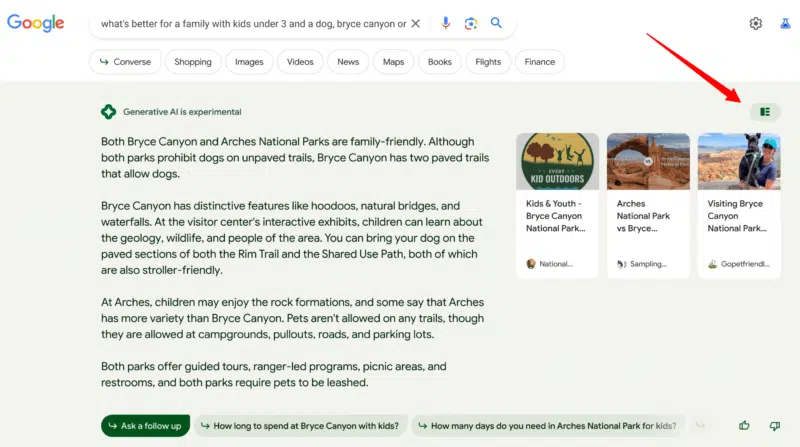
Changes to Google’s organic algorithm, and the Google Ads platform, and even the search results page we see every day, happen often and don’t always amount to much for you. Google Search Generative Experience (SGE) has the potential to make a lot more ripples so you owe it to yourself to be aware of it before it happens.
TL;DR
AI-based search results may mean:
- Fewer searches overall
- Less search traffic – particularly top-of-funnel terms
- A change in how ads are first presented to users – especially mobile users
So you should monitor your paid and organic search results closely as SGE rolls out more widely in May.
So What is Google SGE?
Long story short, SGE means that AI will provide an instant answer to a lot of searches right on the search engine results page (SERP). On the surface, that may not sounds like a big deal. Let’s dig a little deeper.
What does SGE mean for my traffic?
If you get an answer to your question right on the SERP, why would you go anywhere else? And if people don’t go anywhere else – paid or organic – what does that mean for your results? The least attractive scenario is that Google SERPs become a billboard like the ones you drive by on the highway or walk by in the airport. Impressions only. No clicks.
The most important voice that doesn’t want that to happen is Google’s. The lion’s share of its revenue comes from ad clicks – not impressions – so you should have some confidence Google knows that this change doesn’t crush their own bottomline.
Regardless of whether or not people recognize the difference between a paid ad and organic search result, people don’t really come to Google for the ads. Instead, people come to Google to get good answers to their questions. If generative AI can provide a good answer right away with no SERP click or secondary search, users may end their research right there – but the habit of coming to Google for answers continues.
Farewell to TOFU?
No, not the bean curd. You may see less ‘top of funnel’ (TOFU) traffic courtesy of generative AI. That’s because many simple definition, ‘what is’, and ‘how-to’ type queries may now be resolved on the SERPs via SGE with no additional click required. To be fair though, many of these end on the SERP already through rich results. But if your paid or organic program relies on TOFU queries, Google SGE may rock your boat more than most. Middle and bottom-of-funnel queries should not be impacted as much since they are more difficult for AI to answer effectively in a single paragraph or bulleted list.
Our guess is that even when you get a good AI answer to your initial query right on the SERP, it will lead you to either look at the other ‘traditional’ results on the SERPs to see if there’s more information available from a trustworthy source, or drill into the AI results for additional detail which is, in effect, a follow up search.
Google facilitates the latter option with links and citations for the sites on which the AI drew to cobble together its answer. Each time a user drills down into these results is also an opportunity to surface relevant ads along with more organic content.
Below is a SGE result first published by Search Engine Land. Note the suggested follow up question along the bottom (similar to the existing ‘People also ask…’) as well as the sources for the AI answer on the right. The arrow points to a toggle the user can open to dig deeper into their query.
To be included in the list of AI sources is a nod to being an authoritative source – according to Google – for this topic. This is interesting because being an authoritative source has been part of the Google game for a long time.
A big part of being an authoritative source to date has included your site being on the receiving end of links from other ‘trustworthy’ sites on the same or a related topic. So while some pundits speculate that your SEO link game may now be less important than your citation game, we still see good links as being a contributor to making you worthy of being deemed authoritative by the AI.
What About SGE and the Mobile UI?
That is a big question because SGE could push ad content off the screen but that doesn’t sound much like the Google we know. According to Barry Snyder on AndroidCentral, Google may be considering making SGE a paid feature and paid features and advertising are often mutually exclusive.
One cool feature SGE enables on Android is ‘circle to search’. Just like the name implies, if you draw a circle on your screen – at any time – you launch a Google search for whatever you circled. If it takes off, it could result in more searches – many more. It would be Google’s next frontier in turning OPC (other peoples’ content) into ad clicks. Netflix and Disney+ take note.
Regardless, SGE on mobile devices deserves its own discussion so stay tuned – that’ll be our next topic here on the Bottomline.

